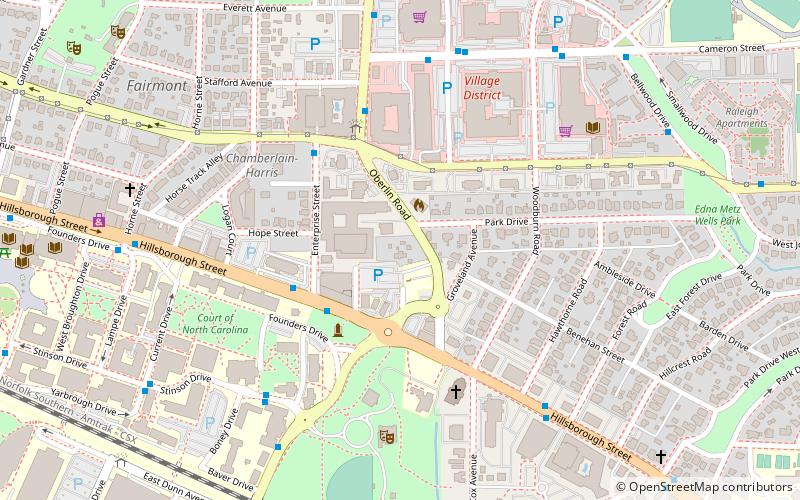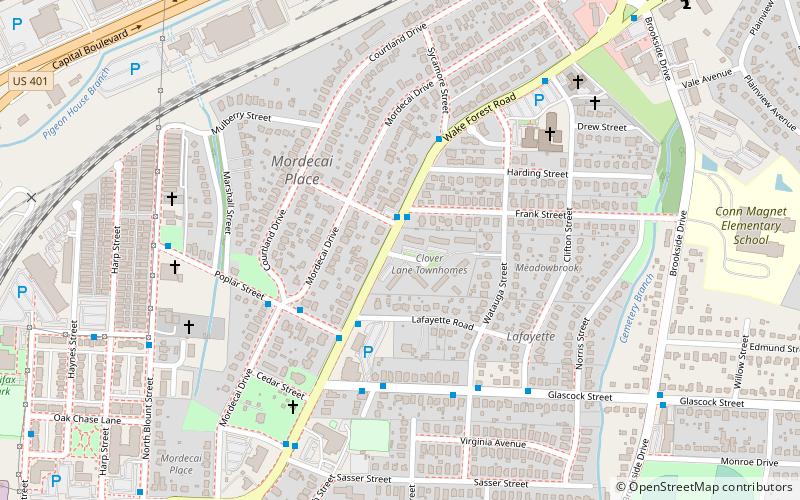Raleigh: Colonial Revival Architecture
Places and attractions in the Colonial revival architecture category
Categories
- Museum
- Church
- Park
- History museum
- Sport
- Sport venue
- Shopping
- Historical place
- Arenas and stadiums
- Shopping centre
- Music venue
- Gothic Revival architecture
- Garden
- Concerts and shows
- Reportedly haunted
- Neighbourhood
- Cemetery
- Queen Anne architecture
- Greek Revival architecture
- Colonial revival architecture
- Neoclassical architecture
- Victorian architecture
- Italianate architecture
- Modernist architecture
Pine Hall
Pine Hall, also known as the Jeremiah Dunn House and Julian Gregory House, is a historic home located at Raleigh, Wake County, North Carolina.
John T. and Mary Turner House
Marshall-Harris-Richardson House is a historic home located at Raleigh, Wake County, North Carolina. It was built about 1889, and is a two-story, side gable I-house with one-story sections at its rear.
Hayes Barton Historic District
The Hayes Barton Historic District is a neighborhood located northwest of downtown Raleigh, North Carolina. Hayes Barton, an upper class neighborhood designed by landscape architect Earle Sumner Draper, contains 457 buildings on 1,750 acres.
Mordecai Place Historic District
Mordecai Place Historic District is a historic neighborhood and national historic district located at Raleigh, North Carolina. The district encompasses 182 contributing buildings and 1 contributing object in the most architecturally varied of Raleigh's early-20th century suburbs for the white middle-class.
West Raleigh Historic District
The West Raleigh Historic District in Raleigh, North Carolina is a national historic district listed on the National Register of Historic Places in 2003.
Isabelle Bowen Henderson House and Gardens
Isabelle Bowen Henderson House and Gardens is a historic home and garden and national historic district located at Raleigh, North Carolina.
East Raleigh–South Park Historic District
The East Raleigh–South Park Historic District is the largest African-American neighborhood in Raleigh, North Carolina. The district, located south and east of downtown Raleigh, covers approximately 30 blocks and contains portions of the Smith–Haywood and St. Petersburg neighborhoods.
Dix Hill
Dix Hill is the informal name for a high, rolling expanse of land and national historic district located at Raleigh, North Carolina. The district encompasses 18 contributing buildings, 1 contributing site, and 3 contributing structures.
Longview Gardens Historic District
Longview Gardens Historic District is a historic post-World War II neighborhood and national historic district located 1+1⁄2 miles east of downtown Raleigh, North Carolina. The district encompasses 189 contributing buildings and five contributing sites.
Maiden Lane Historic District
The Maiden Lane Historic District is a national historic district located at Raleigh, North Carolina. The district encompasses 12 contributing residential buildings and was developed between about 1893 and 1923.
Spring Hill
Spring Hill, also known as the Theophilus Hunter House, is a historic plantation house located at Raleigh, Wake County, North Carolina. It was built between about 1816 and 1820, and is a two-story rectangular Georgian-style frame house with one-story rear wing.
Mary Elizabeth Hospital
Mary Elizabeth Hospital, located on the corner of Wake Forest Road and Glascock Street in Raleigh, North Carolina, was designed by Dr. Harold Glascock and built in 1920. The building still exists on the corner, and is a Raleigh Historic Landmark and is listed on the National Register of Historic Places.
Map












